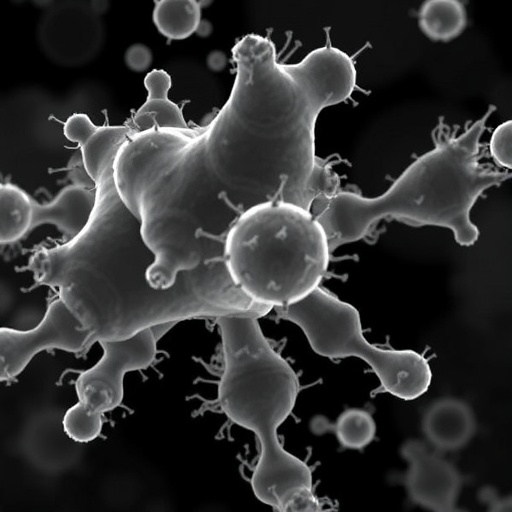The world of microbiology continues to reveal a wealth of information about the complex interactions between bacteria, their bacteriophages, and the environments in which they exist. A recent study published in BMC Genomics by Wang and colleagues has shed significant light on the prophage landscape of Enterococcus faecium, a bacterium that has garnered attention due to its role in human health and disease. This research not only uncovers the diversity of prophages associated with E. faecium but also delves into their associated resistance genes and virulence factors.
Prophages are segments of viral DNA that can integrate into the bacterial genome, representing remnants of bacteriophages that have undergone a lysogenic cycle. The significance of these elements in the E. faecium population cannot be overstated, considering they contribute substantially to horizontal gene transfer, which is a primary mechanism by which bacteria acquire new traits, including antibiotic resistance. Understanding the prophage repertoire of E. faecium is crucial, especially in the context of rising antibiotic resistance rates and the subsequent need for novel therapeutic approaches.
The research team employed advanced genomic analysis techniques to assess a wide array of E. faecium strains isolated from various environments, including clinical settings and agricultural sources. Their findings revealed a remarkable diversity in the prophage content among these strains, highlighting the evolutionary adaptability of E. faecium. The presence of multiple prophages within a single strain suggests a dynamic and complex relationship between this bacterium and its associated phages, which likely influences its pathogenic potential and resource utilization strategies.
Moreover, the identification of resistance genes linked to specific prophage sequences provides critical insights into the genetic mechanisms underlying antibiotic resistance in E. faecium. This is particularly alarming given that E. faecium is known for its ability to harbor and transmit resistance traits, rendering many antibiotics ineffective. The presence of these resistance genes within prophages raises the question of how horizontal gene transfer might accelerate the spread of antibiotic resistance in both clinical and environmental settings.
The study also illuminated the role of virulence factors encoded by the prophages. The presence of genes associated with various virulence mechanisms reinforces the idea that prophages are not merely relics of ancient viral infections but active contributors to the pathogenicity of bacterial strains. This linkage between prophage content and virulence underscores the importance of considering phage elements when assessing the overall pathogenic potential of E. faecium.
In addition to the exigencies surrounding antibiotic resistance, the research explores endolysins, which are enzymes produced by bacteriophages to lyse bacterial cells upon infection. The profiling of endolysins associated with prophages in E. faecium offers tantalizing prospects for therapeutic applications. As antibiotic resistance continues to challenge traditional treatment modalities, endolysins present a potential alternative, providing a basis for developing phage therapy strategies targeted at resistant bacterial strains.
The implications of the findings published by Wang and colleagues extend beyond infection control. Understanding the complex prophage landscape can inform strategies aimed at preventing the spread of harmful strains in clinical settings, helping healthcare providers adopt more effective infection control measures. Furthermore, these insights may also translate into agricultural practices, particularly in managing bacterial populations that contribute to plant and animal health.
Through meticulous analysis, the study also emphasizes the intricate relationship between E. faecium and its prophages within diverse ecosystems. It suggests that environmental factors may play a significant role in shaping the prophage inventory of E. faecium, further extending the relevance of this research to ecological studies of microbial community dynamics. This perspective is vital for understanding how environmental pressures can affect the genetic landscape of important pathogens.
As the scientific community grapples with the challenges posed by the global rise in antibiotic resistance, studies like this one provide a clearer view of the underlying genetic factors at play. They reveal the complexities of microbial life and the ever-present threat of evolving resistance mechanisms. The implications of such research are profound, leading to potential shifts in how we approach treatment, prevention, and the management of infectious diseases.
The key to tackling these pressing issues may lie not only in traditional gene-targeted therapies but also in embracing phage-targeted strategies. As researchers build upon the work of Wang et al., future studies may unveil even more detailed connections between prophage genomes, resistance mechanisms, and virulence traits. This collectively represents an essential step toward maneuvering through the challenging battlefield of bacterial infections and antibiotic resistance.
In conclusion, the compelling findings of this study serve as a critical reminder of the importance of continuous research into the microbiome. By exploring the prophage landscape in E. faecium, Wang and his colleagues cemented our understanding of the genetic intricacies that govern bacterial behavior, resistance, and pathogenicity. As researchers venture further into this uncharted territory, the prospect of more effective antibacterial therapies and more robust frameworks for managing bacterial disease will become increasingly attainable. Such endeavors are not merely academic exercises; they are vital to protecting public health in an era defined by the challenges of antibiotic resistance.
The dialogue generated by this research may fuel multidisciplinary collaborations across microbiology, genomics, and therapeutic development, fostering innovative solutions to the issues at hand. It is essential for the scientific community to remain vigilant as new data continues to emerge, ensuring that we are adequately prepared to confront the evolving landscape of bacterial resistance and infection management.
Subject of Research: Prophage landscape in Enterococcus faecium and its implications for resistance and virulence factors.
Article Title: Prophage landscape in Enterococcus faecium: diversity, resistance genes, virulence factors, and endolysin profiling.
Article References:
Wang, Z., Gao, S., Zhang, Y. et al. Prophage landscape in Enterococcus faecium: diversity, resistance genes, virulence factors, and endolysin profiling.
BMC Genomics 26, 964 (2025). https://doi.org/10.1186/s12864-025-12172-x
Image Credits: AI Generated
DOI: https://doi.org/10.1186/s12864-025-12172-x
Keywords: Prophage, Enterococcus faecium, antibiotic resistance, virulence factors, endolysin profiling, horizontal gene transfer.




